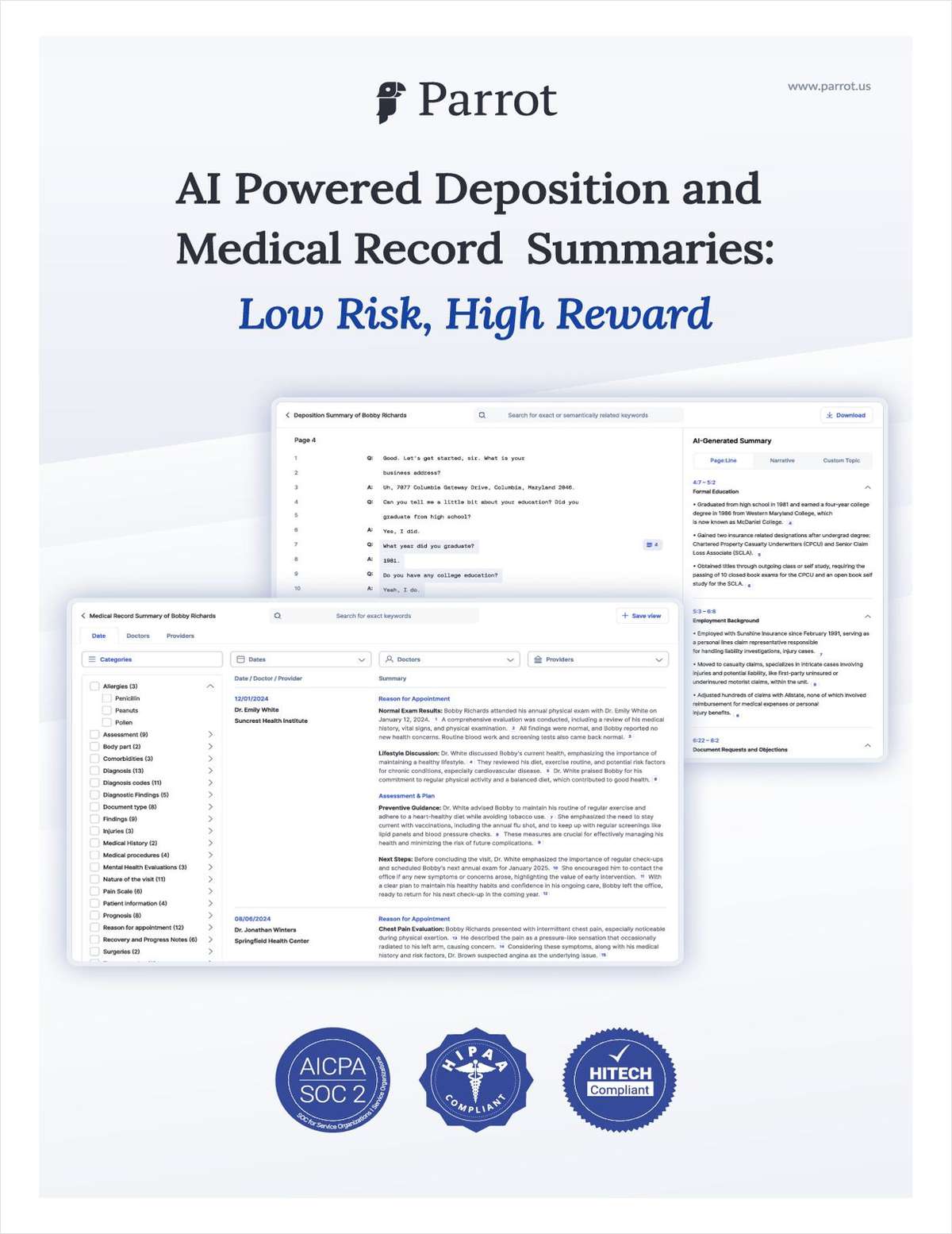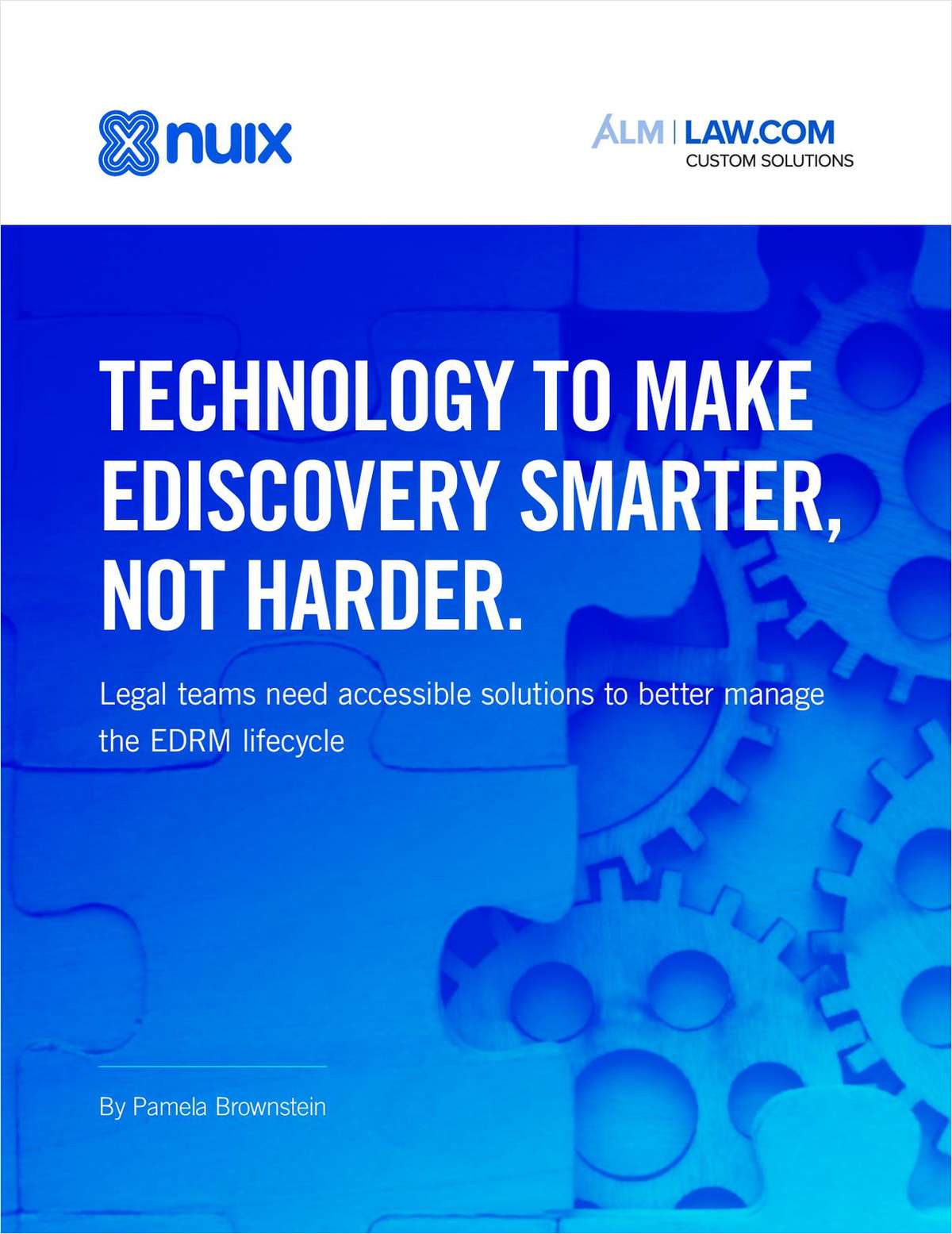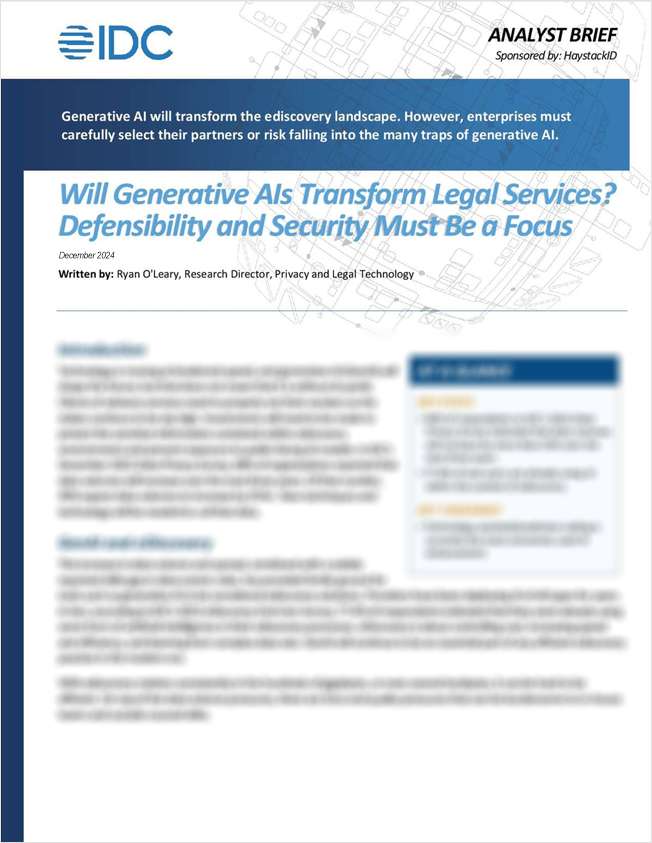Executive Benefits at Nonprofits after the Tax Cuts and Jobs Act
The Tax Cuts and Jobs Act made significant changes to certain Internal Revenue Code provisions dealing with highly compensated employees. Among these are restrictions (in the form of excise taxes) on compensation of certain highly paid employees of “applicable tax-exempt organizations.”
May 08, 2019 at 10:56 AM
10 minute read
This article appeared in Accounting and Financial Planning for Law Firms, an ALM/Law Journal Newsletters publication covering all financial aspects of managing law firms, including: building a law firm budget; rates and rate arrangements with clients; coordinating benefits for law firm partners; and the newest strategies to grow your firm and your career.
The Tax Cuts and Jobs Act (the Act) was passed by the House and Senate and signed into law by President Trump at the end of 2017. The Act made significant changes to certain Internal Revenue Code (Code) provisions dealing with highly compensated employees. Among these are restrictions (in the form of excise taxes) on compensation of certain highly paid employees of “applicable tax-exempt organizations” (i.e., 501(c) organizations, political organizations, and farmers' cooperatives as well as non-profit healthcare systems, hospitals, credit unions,federal, state, and local governmental entities with excludable income).
Effective for all taxable years beginning after Dec. 31, 2017, new Section 4960 imposes an excise tax on applicable tax-exempt organizations where the “remuneration” received by an employee (or former employee) that is one of the five highest compensated employees for any prior taxable year beginning after Dec. 31, 2016 exceeds certain amounts. For this purpose, remuneration includes amounts that become taxable under Section 457(f) upon a lapse of a substantial risk of forfeiture, but excludes amounts paid directly to certain medical professionals for performance of services. Amounts credited under qualified and welfare plans are not included in remuneration. The Section 4960 excise tax equals 21% of the sum of the remuneration exceeding $1M annually. These employers must now comply with the remuneration (compensation and benefits) ceiling for the highest compensated top five employees under §4960 and §162(m). Additionally, once an individual is labeled in that group they will remain in that group so the group may expand and the excise tax is annually applied.
The IRS issued final regulations in June 2016 that provide a roadmap for a successful solution to the excise tax conundrum. A solution applies an actuarially based methodology to provide benefits for selected non-profit executives on a tax-efficient basis. If you already have a plan in place, it is most likely a 457(f) plan for the executive, management and professional employees. This is not meant to replace a plan in existence, rather to compliment it as there are decided differences. Most significant for the participants is the opportunity to provide for their families, a pre-retirement death benefit without risks of forfeiture and with enormous flexibility. This is not an ERISA plan; it does not need a Trustee and the participant and plan sponsor will avoid the claims of creditors while providing for the participant's loved ones. Because this is not a qualified plan and it is not considered deferred compensation by the IRS, the plan can be self-funded and the benefit amounts can vary on a participant-by-participant basis. Because it follows the “top hat” rules, it does not require any form of ongoing or annual filings with any regulatory agencies.
Non-profit organizations have limited opportunities to recruit, retain and reward highly prized executives because of regulatory, economic, human resources, communication and compliance requirements. New rules provided by the IRS offer the opportunity to use a planning tool that will provide a current benefit for the top five executives not otherwise available in the marketplace.
Using the actuarial methodology, the non-profit organization can provide this without requiring additional recordkeeping, reporting, limitation of covered employees, ERISA and qualified plan rules, employee cooperation, regulatory compliance issues and penalties. This §457(e)11 plan provides:
- Economically efficient funding;
- Complies with all regulatory requirements without additional recordkeeping and reporting;
- Avoids the risk of forfeiture requirements under §457(f) and §4960;
- A current death benefit while employed not otherwise available to other employees;
- A patented actuarial methodology to determine the covered participants, the value of the current benefits and the funding of the benefits; and
- Qualifies for exclusion of immediate remuneration recognition required under §457(f), §4960, §162(m) and during funding.
What Is a §457(e)11 Plan?
A §457(e)11 plan is a permissibly selective benefit plan. The death benefit only plan uses a multidisciplinary platform following deferred compensation welfare benefit plan structures with an actuarially determined current benefit provided for employees and independent contractors. The participants are taxed on the economic benefit so long as the benefit is funded by the employer. A §457(e)11 plan is a non-qualified ineligible non-deferred compensation and non-compensation plan (26 CFR1.457-11, IRC 457 Examination Guidelines). (Note: See the decision tree explanation for compliance purposes.)
A plan sponsor must be a tax-exempt entity (TEE) (457[e][1]). A participant may be an employee or independent contractor of a TEE §457(e)(2), 1.457-2(d).
A 457(e)(11) death benefit plan does not have to comply with risk of forfeiture or acceleration of income 457(f) requirements. See, IRC §457(f)(11)(A)(1), Notice 87-13 and 88-68.
Payments by the plan sponsor to fund a §457 (e)(11) death benefit plan are not taxable income, nor deferred compensation, to the participant. See, Office of Chief Counsel (OCC) Memorandum No. INFO 2003-0082 (Feb. 25, 2003).
In the memo, the OCC interpreted Notice 88-68 to indicate that the providing or accruing of the benefits is not a taxable event. Providing the benefit thru a §457(e)11 plan does not affect taxation to the participant, that is addressed under other provisions of the law. The participant funded by the benefit is taxed on the Table 2001 rates as economic benefit. As the death benefit is the only benefit provided by participating in the plan, to the extent the benefit qualifies as life insurance under §101(a), it should not be subject to income tax as received by a beneficiary identified in the plan.
The plan may be elective or non-elective, and a salary reduction or non-salary reduction plan (IRS Notice 88-68 and Notice 87-13Q&A 26).
A §457(e)11 death benefit plan may also be funded with life insurance (REG147196-07 06-21-2016).
Where Can It Be Used?
The benefit program can be provided to non-profit executives (top hat group) providing services to tax exempt entities. A §457(e)11 DBO plan is deemed a “top hat” plan and is available to management, highly compensated professionals and independent contractors. See, IRS Examination Guidelines 4.72-19.
When Can It Be Used?
The benefits can be funded throughout the accounting period and within 75 days of year-end relating back to previous accounting periods, like similar plans. The commencement date is not tied into the beginning or end of any reporting period, which provides additional flexibility. Notice 87-13 Q-26 indicates “in the case of deferrals, §457 applies to both elective and nonelective deferred compensation amounts. In the case of deferrals that are at the election of the individual, §457 applies without regard to whether the deferral election is made prior to the year during which the employee performs the services to which the deferred amounts relate.”
Why Would a Non-Profit Employer Use This Plan?
While non-profits want to recruit, retain and reward highly prized management, professional and independent contractors, they run on very thin margins. Employers want to fund benefits for selected employees in the most economically efficient fashion. See, Notice 87-13, 1987-1 CB432Q-26. The rules permit the funding by way of salary reduction in whole or in part so the non-profit employer can provide benefits with less financial responsibility than other comparative benefit plans.
The §457(e)11 plan is different from any other plan currently being made available to non-profit plan sponsors as it provides a current welfare benefit to selected highly prized employees. Because of the ability to earmark the “top hat” qualified participants, the plan sponsor can permissibly provide a benefit to them and not provide that same benefit to other employees as a class or in a uniform amount.
How Does the §457(e)11 Work?
- Employer and employee enter into mutually beneficial arrangement to provide death benefit during employment.
- Employer funds the life insurance over agreed-upon period.
- Group arrangement uses a co-ownership format to provide coverage plan sponsor expenses contribution.
- The death benefit participant under 457 may fund by way of salary reduction.
- Participant is taxed on the economic benefit using Table 2001.
- Participant's benefit not deemed remuneration for §162(m) and §4960 purposes.
- Program provides death benefit only coverage during the years of employment. No distributions other than death benefit are allowed. Plan sponsor and participant are restricted in access.
- Permanent life policies accrue on tax-free basis.
- Policies are reviewed annually.
- Economic benefit costs stop once contributions are no longer made. No tax reporting upon termination of the benefit arrangement.
- After termination of benefit plan, co-ownership arrangement is evaporated.
- Insured may access cash values of policies, or use polices for their personal financial and estate planning.
Administration of the Plan
The §457(e)11 death benefit only plan is not a qualified plan nor deferred compensation or an ERISA plan. The DOL has specific administrative rules that requires the following:
- Name, address, including email address of plan administrator;
- Permits, but does not require, plan name to be stated;
- Does not require providing plan document; and
- Requires a box to be checked if it is an amended notice.
The website to enroll is www.askebsa.dol.gov/efile/Home/tophat.
The Plan Administrator will have to electronically enroll the plan at the time of implementation and will provide proof of filing to the plan sponsor.
Third Party Validation
At the time of implementation, the 457(e)11 plan should receive validation from an independent third party:
- A well-reasoned legal memorandum indicating that the plan complies with all applicable regulatory requirements;
- An actuarial report supporting the contribution and reflecting the cost of the current death benefit thru age 67; and
- A report from an actuarial firm should indicate that the amount of the funding of the policy meets required benchmarks to qualify under §457(e)11 as a bona fide death benefit plan.
No other benefit plan available to non-profits provides this multidisciplinary tool to recruit, retain and reward the non-profit's highly prized employees and independent contractors. If a non-profit organization is not currently using this planning tool, they are missing out on the opportunities and they may look elsewhere and desert the service provider (your client). This is another leg of the stool to provide executive benefits in the most economically efficient manner while being regulatory compliant.
To hear an interview with the developer of the program, go to http://bit.ly/2yvoXOo.
*****
Lawrence L. Bell, JD, LTM, CLU, ChFC, CFP®, AEP, a member of this newsletter's Board of Editors, has served as Tax Bar liaison to the IRS for 10 years. He has received patents in actuarial product fields dealing with COLI, GASB, FASB, IASB and OPEB solutions. To learn more, visit www.mycpo.net.
This content has been archived. It is available through our partners, LexisNexis® and Bloomberg Law.
To view this content, please continue to their sites.
Not a Lexis Subscriber?
Subscribe Now
Not a Bloomberg Law Subscriber?
Subscribe Now
NOT FOR REPRINT
© 2025 ALM Global, LLC, All Rights Reserved. Request academic re-use from www.copyright.com. All other uses, submit a request to [email protected]. For more information visit Asset & Logo Licensing.
You Might Like
View All
'Ridiculously Busy': Several Law Firms Position Themselves as Go-To Experts on Trump’s Executive Orders
5 minute read
Big Law Sidelined as Asian IPOs in New York Are Dominated by Small Cap Listings


The Law Firm Disrupted: For Office Policies, Big Law Has Its Ear to the Market, Not to Trump
Trending Stories
- 1Will Madrid Become the Next Arbitration Hub?
- 2‘Ripe for SCOTUS’: Ruling Creates Circuit Split on NLRB’s Expanded Monetary Remedies
- 3'They Are Never Going to Learn': Geico Not Protected by Litigation Privilege
- 4Supreme Court Takes Up Case Over Approval of Religious Charter School
- 5Gifts of Interest in Charitable LLCs
Who Got The Work
J. Brugh Lower of Gibbons has entered an appearance for industrial equipment supplier Devco Corporation in a pending trademark infringement lawsuit. The suit, accusing the defendant of selling knock-off Graco products, was filed Dec. 18 in New Jersey District Court by Rivkin Radler on behalf of Graco Inc. and Graco Minnesota. The case, assigned to U.S. District Judge Zahid N. Quraishi, is 3:24-cv-11294, Graco Inc. et al v. Devco Corporation.
Who Got The Work
Rebecca Maller-Stein and Kent A. Yalowitz of Arnold & Porter Kaye Scholer have entered their appearances for Hanaco Venture Capital and its executives, Lior Prosor and David Frankel, in a pending securities lawsuit. The action, filed on Dec. 24 in New York Southern District Court by Zell, Aron & Co. on behalf of Goldeneye Advisors, accuses the defendants of negligently and fraudulently managing the plaintiff's $1 million investment. The case, assigned to U.S. District Judge Vernon S. Broderick, is 1:24-cv-09918, Goldeneye Advisors, LLC v. Hanaco Venture Capital, Ltd. et al.
Who Got The Work
Attorneys from A&O Shearman has stepped in as defense counsel for Toronto-Dominion Bank and other defendants in a pending securities class action. The suit, filed Dec. 11 in New York Southern District Court by Bleichmar Fonti & Auld, accuses the defendants of concealing the bank's 'pervasive' deficiencies in regards to its compliance with the Bank Secrecy Act and the quality of its anti-money laundering controls. The case, assigned to U.S. District Judge Arun Subramanian, is 1:24-cv-09445, Gonzalez v. The Toronto-Dominion Bank et al.
Who Got The Work
Crown Castle International, a Pennsylvania company providing shared communications infrastructure, has turned to Luke D. Wolf of Gordon Rees Scully Mansukhani to fend off a pending breach-of-contract lawsuit. The court action, filed Nov. 25 in Michigan Eastern District Court by Hooper Hathaway PC on behalf of The Town Residences LLC, accuses Crown Castle of failing to transfer approximately $30,000 in utility payments from T-Mobile in breach of a roof-top lease and assignment agreement. The case, assigned to U.S. District Judge Susan K. Declercq, is 2:24-cv-13131, The Town Residences LLC v. T-Mobile US, Inc. et al.
Who Got The Work
Wilfred P. Coronato and Daniel M. Schwartz of McCarter & English have stepped in as defense counsel to Electrolux Home Products Inc. in a pending product liability lawsuit. The court action, filed Nov. 26 in New York Eastern District Court by Poulos Lopiccolo PC and Nagel Rice LLP on behalf of David Stern, alleges that the defendant's refrigerators’ drawers and shelving repeatedly break and fall apart within months after purchase. The case, assigned to U.S. District Judge Joan M. Azrack, is 2:24-cv-08204, Stern v. Electrolux Home Products, Inc.
Featured Firms
Law Offices of Gary Martin Hays & Associates, P.C.
(470) 294-1674
Law Offices of Mark E. Salomone
(857) 444-6468
Smith & Hassler
(713) 739-1250








